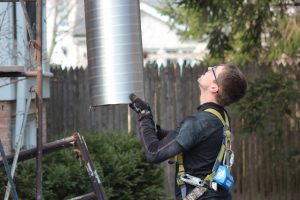
A chimney liner is the innermost part inside a chimney that can be made of clay, cement, or metal. Its primary functions are to contain combustible products and vent them to the outside, as well as to protect the chimney walls from damage from heat.
A chimney may need relining due to one of the following factors:
• Damage- Over time the liner in your chimney may begin to deteriorate and develop cracks and holes.
• Improper installation- Liners that are improperly installed may not adequately handle the heat and combustion in your chimney.
• Resizing- If you’re installing a new stove or fireplace, the liner may have to be a different size so that it works effectively.
• No liner- If your home is old enough your chimney may not have a liner at all!
Obviously the liner plays an important part inside your chimney, but it’s not something that is necessarily obvious when it needs replacing. An inspection will determine the condition (or existence) of your chimney liner.
There are three types of chimney liners:
• Metal- Usually made of stainless steel or aluminum, this type of liner is the preferred choice by the professionals. While stainless steel is more costly than clay or cement, it can be used with any kind of fuel and lasts for a very long time.
• Clay tiles- The least expensive and most common type of chimney liner. These can last up to 50 years with proper maintenance.
• Cast-in place- Much like clay, this type of liner can last for many years with proper maintenance. It is a different type of installation process than clay as the mortar is cast right into the chimney itself.
If your chimney needs relining, our professionals can help determine what kind of liner will best suit your needs. Not sure what the line on your liner is? Give Smith’s Chimney Service a call today and we can give you the answers!
